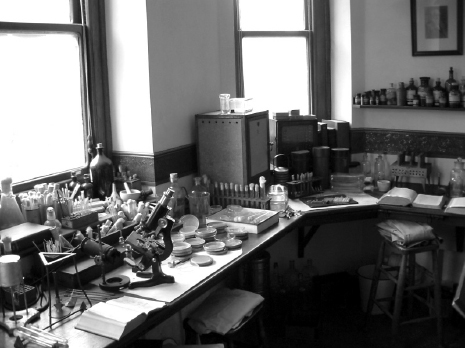038
Alexander Fleming Laboratory Museum, London, England
![]()
Fleming’s Cramped Laboratory
Antibiotics and penicillin are likely the first things that come to mind when the name Alexander Fleming is mentioned. And, certainly, Fleming did accidentally discover in 1928 that the fungus Penicillium notatum prevented the bacteria staphylococcus from spreading in a culture dish. But the story of antibiotics is much larger than Fleming’s discovery, and this museum is the place to get the complete picture.
The museum, spread over four floors, has an in situ reconstruction of Fleming’s 1928 laboratory (Figure 38-1), complete with his microscope, samples of Penicillium notatum prepared by Fleming himself, a culture plate showing the effect of penicillin mold on Staphylococcus aureus (the most common cause of staph infections) and on B. Coli (a bacteria that resides happily in pigs and can jump over to humans, resulting in severe bowel problems), and a culture dish showing penicillinase (the enzyme responsible for penicillin resistance).
While Fleming is the star of antibiotic research, he wasn’t the first to produce an antibiotic. His 1929 paper on his discovery, which shows that he tested penicillin against a range of pathogens, was largely ignored. And Fleming never produced penicillin in a quantity suitable for treating an infected person. That honor goes to Florey and Chain (page 209), who shared the Nobel Prize with Fleming in 1945.
Prior to penicillin’s arrival on the market, the antibiotic salvarsan (first marketed in 1910) created by the German scientist Paul Ehrlich was successfully used in treating syphilis. Another antibiotic, Prontosil, was largely created by another German, Gerhard Domagk, and was marketed in 1935 as a treatment for streptococcus. It was rapidly discovered (at the Institut Pasteur; see Chapter 11) that Prontosil was metabolized into sulfanilamide, and that sulfanilamide was the actual antibiotic; this led to a whole range of “sulfa” antibiotics that were active against a wide range of diseases in the early 1940s. Penicillin itself became widely available in 1942. Subsequently, streptomycin (which is used to treat plague) came on the market in 1944.

Figure 38-1. Fleming’s laboratory today; courtesy of the Alexander Fleming Laboratory Museum (Imperial College Healthcare NHS Trust)
Penicillin is the most famous antibiotic, in part because of its role in the Second World War and especially because of its ability to deal with sexually transmitted diseases. The museum puts Fleming’s work in the context of other antibiotic research, and explains the difficulty that was encountered in mass-producing penicillin in time for D-Day.
In addition, the museum is especially interesting because the enthusiastic curator, Kevin Brown, has written the definitive guide to Alexander Fleming in his book Penicillin Man (The History Press).
Practical Information
The somewhat tricky-to-find website for the Alexander Fleming Laboratory Museum is at http://www.imperial.nhs.uk/aboutus/museumsandarchives/. The museum itself is not tricky to find: it’s at St. Mary’s Hospital in London, right next to Paddington Station. All visits to the laboratory are escorted, and your guide will provide commentary along the way.

